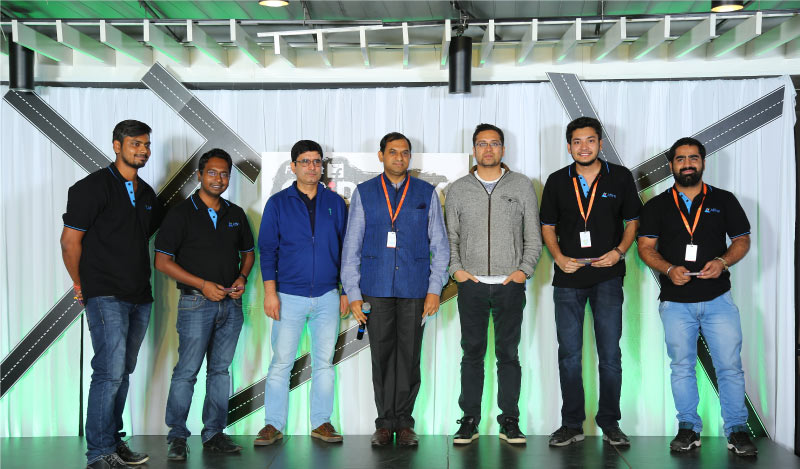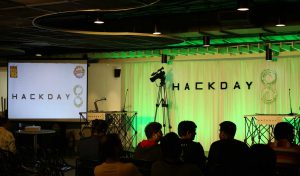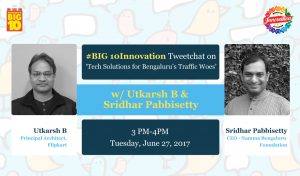In its tenth year of innovating for India, Flipkart wanted its hometown Bengaluru to put behind its unsavory reputation for being a congested, traffic-choked city. Flipkart invited tech thinkers and concerned citizens to put their minds to work and innovate to find solutions to this decades-long civic problem. Ergo, the Gridlock Hackathon, a unique event that brought these minds together. An eminent jury, smart peers and exciting prizes just added to the motivating factors. The contest ran from June 7 to July 8, 2017. Nearly 3,000 registrations flowed in and over 1,000 teams joined the hackathon. In the end, the best ideas won the race to solve Bengaluru’s traffic woes. Here’s an update from the grand finale.
And the winners are:
Snapshots from the event:


#Bengaluru! It's time to give something back to ur city. Join @Flipkart #GridlockHackathon & submit innovative ideas https://t.co/oris9OAO9Q
— binnybansal (@binnybansal) June 14, 2017

GIS based real-time signal automation, car pooling, IoT solutions at Flipkart’s Gridlock Hackathon @binnybansal https://t.co/akFoMO1wgf
— Abhishek Goyal (@goyal_abhei) July 10, 2017

3 solutions to Bengaluru’s #traffic woes that sprung from #Flipkart’s #GridlockHackathon #amazon #uber #ola https://t.co/neOXhq7OQo pic.twitter.com/WZ7oy0nwUe
— YourStory (@YourStoryCo) July 10, 2017
Congratulations @teamAffine! Winners of #GridlockHackathon! #Flipkart You Indeed Unlocked The Grid! pic.twitter.com/GGXEbW99Ad
— Affine (@Affine_ai) July 8, 2017
For more news updates on Flipkart Gridlock Hackathon, click here.
What was the Gridlock Hackathon?
The Gridlock Hackathon was a one-of-a-kind hackathon to crowd-source innovative, implementable solutions from the tech community and concerned citizens to help ease Bengaluru’s traffic problem. Bengaluru, dubbed India’s Silicon Valley or India’s Startup Capital, is world-renowned for being a hub of innovation, cutting-edge research, and top tech talent. But the city also carries the tag of being India’s third-most populous urban agglomeration, having enjoyed for decades a preferred status among students, job-seekers and global companies. The population influx, combined with rising aspirations and inadequate infrastructure, has caused Bengaluru to burst at the seams, giving rise to a perennial problem: Traffic Gridlock.
Do you have the smarts to solve Bengaluru's traffic problems? Submit your ideas to @Flipkart #GridlockHackathon –> https://t.co/Xptpkfa0hF pic.twitter.com/DBVWr5nxU0
— Flipkart Stories (@FlipkartStories) June 8, 2017
Flipkart, as an innovative technology company born in Bengaluru, firmly believes that all new innovation should benefit society at large. Flipkart decided to bring together the developer community in the city and concerned citizen to collectively find workable solutions to Bengaluru’s traffic woes.
During the ‘Month of Innovation’ in June, part of Flipkart’s 10th anniversary celebrations, Flipkart invited these aspiring problem solvers to a ‘Gridlock Hackathon’ — a hackathon that crowd-sourced innovative, implementable ideas to help ease the city’s traffic situation.
The contest ran from June 7 to July 8. The Gridlock Hackathon invited technology-centric solutions, as well as those that partially leveraged technology through out-of-the-box thinking.
Gridlock Hackathon – Participation process
Interested participants submitted proposals that address macro problems like overall traffic in Bengaluru or traffic snares in specific areas (example: Silk Board Junction, KR Puram Junction, etc.). Submissions included a mix of entirely technology-centric solutions as well as ones that partially leveraged technology in relevant and smart way, to address problems related to Bangalore traffic.
Teams:
- Individual entries were allowed
- Maximum team size: 4 participants per team
- Participants were allowed to submit multiple entries
Data:
- Participants were also allowed to use any publicly available APIs like Google Maps, etc.
- Participants also came up with their own databases/ used dummy data-sets to simulate traffic conditions
Judging criteria
Entries were judged on the following parameters:
- Impact: How big was the problem that was being addressed, and how relevant was the solution?
- Feasibility: Was there potential for the solution to be implemented in the face of real-world challenges?
- Scalability & Sustainability: Is the solution long-lasting, and could it scale for the real-world, possibly through relevant application of technology?
- Completeness: Entries required a working prototype, or a demonstrable proof-of-concept
Phase 1: Online submissions
In Phase 1, participants submitted their entries via the Hackerearth website.
Entries were to be in the following format:
- PowerPoint(PPT) /Slide deck of max 8 slides:
- 1 slide – context/scope
- 1 slide – problem description
- 2-3 slides – analysis/research on why problem exists
- 2-3 slides – proposed solution
- 1 slide – Links to all supporting documents including code repositories (a GitHub link is preferred) and instructions on how to execute the code
- Demo video (optional)
Participants were allowed to either:
i) Upload a .zip file/folder of the slide deck/video directly to the event page on Hackerearth; or
ii) Upload the PowerPoint/slide deck/video to a Google Drive and share the link on Hackerearth
Phase 2: Final Demo
The top 10 entries were short-listed based on the judging criteria. Short-listed participants then conducted a demo before the jury for 10 minutes. The venue for the Final Demo was Flipkart’s PW office.
Prizes
1st Prize: Flipkart Gift Voucher for ₹200,000
2nd Prize : Flipkart Gift voucher for ₹100,000
3rd Prize : Flipkart Gift Voucher for ₹50,000
Winners
The winning entries were owned by the individuals/teams who came up with the best solutions. Click here to view the winners.






